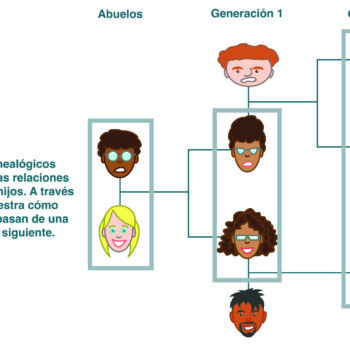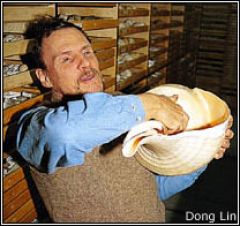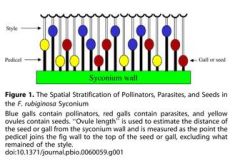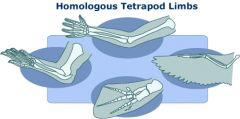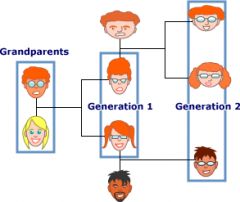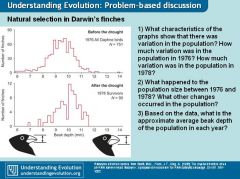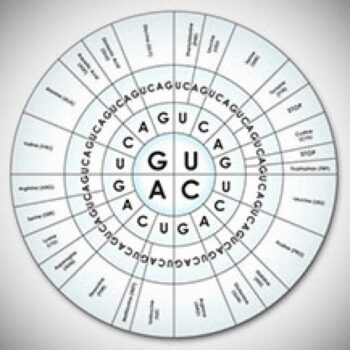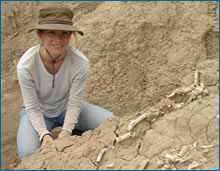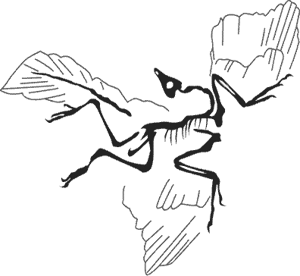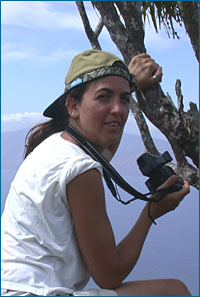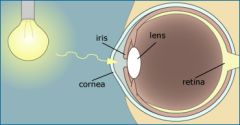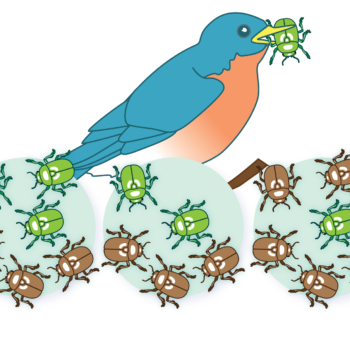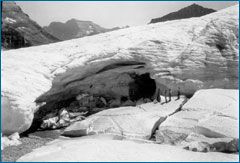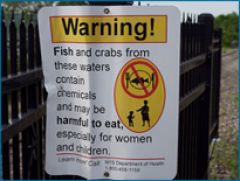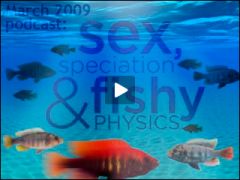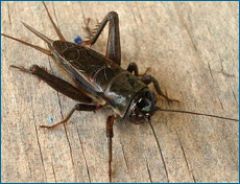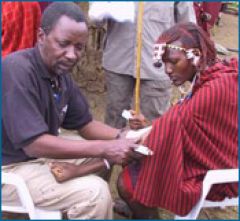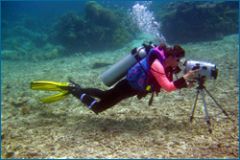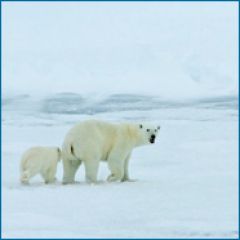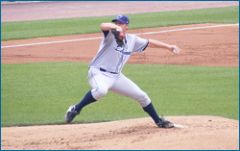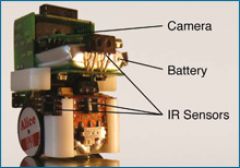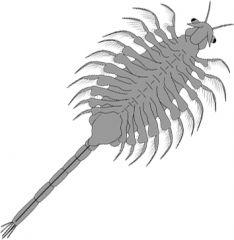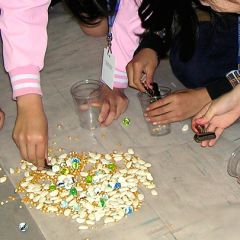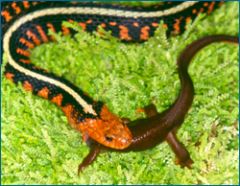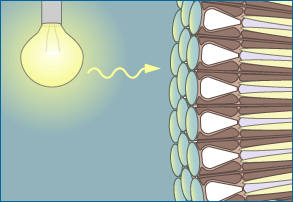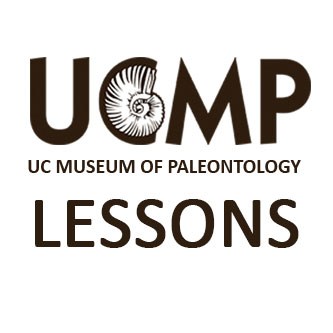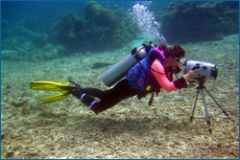Search by:
Found 47 resources:
Semejanzas y diferencias: Comprendamos las homologías y evolución convergente (nivel secundaria)
Grade Level(s):
- 6-8
Source:
- UC Museum of Paleontology
Resource type:
- Online activity or lab
Time: 30 minutes
Overview
Esta investigación interactiva explica qué son las homologías, cómo reconocerlas y cómo es que evolucionan.
Semejanzas y diferencias: Comprendamos las homologías y evolución convergente (nivel bachillerato)
Grade Level(s):
- 9-12
Source:
- UC Museum of Paleontology
Resource type:
- Online activity or lab
Time: 30 minutes
Overview
Esta investigación interactiva explica qué son las homologías, cómo reconocerlas y cómo es que evolucionan.
Interview: Geerat Vermeij on the Fossil record
Grade Level(s):
- 9-12
Source:
- California Academy of Sciences
Resource type:
- Interview with Scientist
Time: 20-30 minutes
Overview
This interview with MacArthur Fellow and paleobiologist, Geerat Vermeij, covers much ground, including adaptations in the mollusks he studies, evolutionary arms races, punctuated equilibrium, extinctions, macroevolution, and the value of diversity.
Stabilization of the fig-pollinator mutualism
Grade Level(s):
- 13-16
Source:
- UC Museum of Paleontology
Resource type:
- Annotated journal article
Time: 1 hour
Overview
Students read a 2008 paper on the role of parasites in stabilizing the fig-pollinator mutualism alongside an interactive guide that explains each section of the paper and draws the reader's attention to important points in the article.
Similarities and differences: Understanding homology and convergent evolution
Grade Level(s):
- 6-8
Source:
- UC Museum of Paleontology
Resource type:
- Online activity or lab
Time: 30 minutes
Overview
This interactive investigation explains what homologies are, how to recognize them, and how convergent traits evolve.
Similarities and differences: Understanding homology and convergent evolution
Grade Level(s):
- 9-12
Source:
- UC Museum of Paleontology
Resource type:
- Online activity or lab
Time: 30 minutes
Overview
This interactive investigation explains what homologies are, how to recognize them, and how convergent traits evolve.
Problem-based discussion: Natural selection in Darwin’s finches
Grade Level(s):
- 13-16
Source:
- UC Museum of Paleontology
Resource type:
Time: 5-20 minutes
Overview
This set of two PowerPoint slides featuring questions for problem-based discussion (i.e., open-ended questions that engage students with each other and with course material) can be easily incorporated into lectures on natural selection.
Preying on Beans
Grade Level(s):
- 3-5
Source:
- UC Museum of Paleontology
Resource type:
- Classroom activity
Time: 50-60 minutes
Overview
Students act as predators searching for prey (beans) in two different settings to demonstrate the processes of adaptation and selection.
Natural selection and evolution of rock pocket mouse populations
Grade Level(s):
- 13-16
Source:
- Howard Hughes Medical Institute
Resource type:
- Classroom activity
Time: 50 minutes
Overview
This lesson serves as an extension to the Howard Hughes Medical Institute short film The Making of the Fittest: Natural Selection and Adaptation. It provides an opportunity for students to analyze amino acid data and draw conclusions about the evolution of coat-color phenotypes in the rock pocket mouse.
The Natural Selection Game
Grade Level(s):
- 9-12
- 13-16
Source:
- Gendron, Robert
Resource type:
- Classroom activity
Time: 1 to 2 class periods
Overview
This is a board game that simulates natural selection. It is suitable for an introductory biology class and for more advanced classes where you could go into more detail on important principles such as the role of variation and mutation.
The Making of the Fittest: Natural Selection and Adaption
Grade Level(s):
- 6-8
- 9-12
- 13-16
Source:
- Howard Hughes Medical Institute
Resource type:
- Video
Time: 10 minutes
Overview
This 10-minute film describes the research of Dr. Michael Nachman and colleagues, whose work in the field and in the lab has documented and quantified physical and genetic evolutionary changes in rock pocket mouse populations.
The genes that lie beneath: The work of Leslea Hlusko
Grade Level(s):
- 9-12
- 13-16
Source:
- UC Museum of Paleontology
Resource type:
- Research profile
Time: 40 minutes
Overview
Evolutionary biologist Leslea Hlusko's research takes her from the deserts of Ethiopia, where she hunts for hominid and primate fossils, to a baboon colony in San Antonio where she takes thousands of measurements of the primates' imposing canines. This research profile describes how the two projects are linked by a hunt for genetic variation, a key component of natural selection.
The Evolution of Flight in Birds
Grade Level(s):
- 9-12
Source:
- UC Museum of Paleontology
Resource type:
- Online activity or lab
Overview
This interactive module examines evidence from the fossil record, behavior, biomechanics and cladistic analysis to interpret the sequence of events that led to flight in the dinosaur lineage.
Mealworm Metamorphosis
Grade Level(s):
- 3-5
Source:
- UC Museum of Paleontology
Resource type:
- Classroom activity
Time: 50-60 minutes for initial observation and set up. Approx. 10-15 minutes for daily observations.
Overview
Students will observe offspring (mealworms) that do not initially resemble their parent organism (darkling beetles) throughout complete metamorphosis. Students will also create and maintain an appropriate habitat for the mealworms.
Mantis shrimp shoulder their evolutionary baggage and bluff
Grade Level(s):
- 6-8
- 9-12
- 13-16
Source:
- UC Museum of Paleontology
Resource type:
- Article
Time: 30 minutes
Overview
Like all organisms, mantis shrimp carry baggage from their evolutionary history. Find out how this baggage has coaxed them into a deadly bluffing game.
Investigating Natural Selection
Grade Level(s):
- 9-12
- 13-16
Source:
- National Academy of Sciences
Resource type:
- Classroom activity
Time: Three class periods
Overview
Students experience one mechanism for evolution through a simulation that models the principles of natural selection and helps answer the question: How might biological change have occurred and been reinforced over time?
How boogieing birds evolved: The work of Kim Bostwick
Grade Level(s):
- 9-12
- 13-16
Source:
- UC Museum of Paleontology
Resource type:
- Research profile
Time: 30 minutes
Overview
This research profile follows ornithologist Kim Bostwick through the jungles of Ecuador and the halls of museums as she investigates the evolution of an exotic bird's complex mating dance.
High altitude adaptations: The work of Emilia Huerta-Sánchez
Grade Level(s):
- 13-16
Source:
- UC Museum of Paleontology
Resource type:
- Research profile
Time: 30 minutes
Overview
This research profile follows statistician and population geneticist Emilia Huerta-Sánchez as she studies the adaptations that allow Tibetan highlanders to live 13,000 feet above sea level without developing altitude sickness.
Using trees to understand plants: The work of Chelsea Specht
Grade Level(s):
- 9-12
- 13-16
Source:
- UC Museum of Paleontology
Resource type:
- Research profile
Time: 30 minutes
Overview
This research profile follows scientist Chelsea Specht as she pieces together the evolutionary history of tropical plants and their pollinators--and in the process, tries to figure out how to conserve endangered species.
Form and Function
Grade Level(s):
- K-2
Source:
- Janulaw, Sharon
Resource type:
- Classroom activity
Time: One period
Overview
Students select a part of a plant or animal and indicate how the part supports the needs of the living thing.
Eye Evolution
Grade Level(s):
- 13-16
Source:
- UC Museum of Paleontology
Resource type:
- Online activity or lab
Time: 45-60 minutes
Overview
This worksheet guides students through an interactive online module entitled Why the Eye? on the Understanding Evolution website. Students gain a better understanding of the different types of animal eyes and how natural selection can account for the evolution of a complex organ.
Evolution 101
Grade Level(s):
- 9-12
- 13-16
Source:
- UC Museum of Paleontology
Resource type:
- Tutorial
Time: multiple days
Overview
This in-depth, multi-part course takes you through evolutionary theory and mechanisms, from definitions to details, natural selection to genetic drift, mutations to punctuated equilibrium.
Evolución 101
Grade Level(s):
- 9-12
- 13-16
Source:
- UC Museum of Paleontology
Resource type:
- Article
Overview
¿Qué es la evolución y cómo funciona? Introducción a la evolución ofrece información detallada y práctica sobre los patrones y los mecanismos de la evolución.
Evo in the news: Warming to evolution
Grade Level(s):
- 9-12
- 13-16
Source:
- UC Museum of Paleontology
Resource type:
- Evo in the News article
Time: 15 minutes
Overview
Global warming increasingly affects many aspects of our environment, from the sea level to tropical storm strength. But that's far from the full story. This news brief from July 2006 describes how global warming has already begun to affect the evolution of several species on Earth.
Evo in the news: Toxic river means rapid evolution for one fish species
Grade Level(s):
- 9-12
- 13-16
Source:
- UC Museum of Paleontology
Resource type:
- Evo in the News article
Time: 10 minutes
Overview
This news brief from March 2011 examines the genetic basis for the evolution of resistance to PCBs in the Hudson River tomcod. Though this is great for the tomcod, what might it mean for other organisms in the ecosystem?
Viruses and Host Evolution
Grade Level(s):
- 9-12
Source:
- Chamberlain, Don
Resource type:
- Classroom activity
Time: Four class periods
Overview
Students learn about natural selection in rabbits by observing the effects of a virus on the Australian rabbit population.
Evo in the news: Sex, speciation, and fishy physics
Grade Level(s):
- 9-12
- 13-16
Source:
- UC Museum of Paleontology
Resource type:
- Evo in the News article
Time: 20 minutes
Overview
More than 500 species of cichlid fish inhabit Africa's Lake Victoria. This news brief from March 2009 explains new research suggesting that the physics of light may have played an important role in cichlid diversification and in the recent drop in their diversity.
Evo in the news: Quick evolution leads to quiet crickets
Grade Level(s):
- 9-12
- 13-16
Source:
- UC Museum of Paleontology
Resource type:
- Evo in the News article
Time: 20 minutes
Overview
The tropical island of Kauai has always been a quiet place, but now it may be getting even more quiet. This news brief, from December 2006, reveals how Kauai's cricket population has evolved into a "chirpless" variety in just a few years.
Evo in the news: Quick bites and quirky adaptations
Grade Level(s):
- 9-12
- 13-16
Source:
- UC Museum of Paleontology
Resource type:
- Evo in the News article
Time: 15 minutes
Overview
Trap-jaw ants made headlines with the record-breaking speed of their jaws and a quirky behavior: flinging themselves into the air using the power of their mandibles. This news brief from October 2006 reveals the evolutionary story behind the headlines.
Evo in the news: Got lactase?
Grade Level(s):
- 9-12
- 13-16
Source:
- UC Museum of Paleontology
Resource type:
- Evo in the News article
Time: 20 minutes
Overview
The ability to digest milk is a recent evolutionary innovation that has spread through some human populations. This news brief from April 2007 describes how evolution has allowed different human populations to take advantage of the nutritional possibilities of dairying and links evolution with the prevalence of lactose tolerance among people of different ethnicities.
Evo in the news: Evolution’s dating and mating game
Grade Level(s):
- 9-12
- 13-16
Source:
- UC Museum of Paleontology
Resource type:
- Evo in the News article
Time: 20 minutes
Overview
This news brief from May of 2008 describes new research on octopus mating and reveals how evolution can favor some surprising courtship behaviors.
Evo in the news: Coping with climate change
Grade Level(s):
- 9-12
- 13-16
Source:
- UC Museum of Paleontology
Resource type:
- Evo in the News article
Time: 20 minutes
Overview
This news brief from May 2009 explores the difference between phenotypic plasticity and evolutionary change in relation to the media's coverage of climate change.
Evo in the news: Bad at estimating? Blame evolution
Grade Level(s):
- 13-16
Source:
- UC Museum of Paleontology
Resource type:
- Evo in the News article
Time: 15 minutes
Overview
Scientists have long noted the universality of the size-weight illusion and formulated different hypotheses to explain it. Now new research suggests that this error may actually be an adaptation with roots in an important but sometimes overlooked aspect of human evolution: throwing skill.
Evo in the News: “Error. Greed does not compute.”
Grade Level(s):
- 9-12
- 13-16
Source:
- UC Museum of Paleontology
Resource type:
- Evo in the News article
Time: 10 minutes
Overview
This news brief from May 2011 describes how researchers are using tiny robots to study the evolution of altruistic behaviors.
Coping with Environmental Differences
Grade Level(s):
- 3-5
Source:
- UC Museum of Paleontology
Resource type:
- Classroom activity
Time: One class period for initial set up. Approx. 10-15 minutes for daily observations.
Overview
Students will observe and conduct an experiment to see whether differences in salinity (the environment) have an affect on the hatching rate and survival of brine shrimp.
Clipbirds
Grade Level(s):
- 6-8
- 9-12
Source:
- UC Museum of Paleontology
Resource type:
- Classroom activity
Time: One class period
Overview
Students learn about variation, reproductive isolation, natural selection, and adaptation through this version of the bird beak activity.
Candy Dish Selection
Grade Level(s):
- 9-12
- 13-16
Source:
- Tang, Carol
Resource type:
- Classroom activity
Time: 30 minutes
Biological warfare and the coevolutionary arms race
Grade Level(s):
- 9-12
- 13-16
Source:
- UC Museum of Paleontology
Resource type:
- Article
Time: 45 minutes
Overview
The rough-skinned newt looks harmless enough but is, in fact, packed full of one of the most potent neurotoxins known to man. Find out how an evolutionary arms race has pushed these mild-mannered critters to the extremes of toxicity and how evolutionary biologists have unraveled their fascinating story.
Adaptation: The case of penguins
Grade Level(s):
- 9-12
Source:
- Visionlearning
Resource type:
- Article
Time: 20 minutes
Overview
The process of natural selection produces stunning adaptations. Learn about the history of this concept, while you explore the incredible adaptations that penguins have evolved, allowing them to survive and reproduce in a climate that reaches -60°C!
This article appears at Visionlearning.
Why the eye?
Grade Level(s):
- 13-16
Source:
- UC Museum of Paleontology
Resource type:
- Article
Time: 30-45 min
Overview
Eyes are something of an icon of evolution. How did such an integrated, multi-part adaptation evolve? While many different animals have complex eyes, untangling their evolutionary history reveals both remarkable diversity and surprising similarity.
Webcast: Endless forms most beautiful
Grade Level(s):
- 9-12
Source:
- Howard Hughes Medical Institute
Resource type:
- Video Lecture
Time: 60 minutes
Overview
In lecture one of a four part series, evolutionary biologist Sean Carroll discusses Darwin and his two most important ideas: natural selection and common ancestry.
This lecture is available from Howard Hughes' BioInteractive website.
Big Beans, Little Beans
Grade Level(s):
- 6-8
Source:
- UC Museum of Paleontology
Resource type:
- Classroom activity
Time: Variable
Overview
Students measure and note the variation in the lengths of lima beans. Students then compare the growth rate of different sized beans.
Battle of the Beaks
Grade Level(s):
- 6-8
Source:
- UC Museum of Paleontology
Resource type:
- Classroom activity
Time: Two class periods.
Overview
Students learn about adaptive advantage, based on beak function, by simulating birds competing for various foods.
Adaptation to altitude
Grade Level(s):
- 9-12
- 13-16
Source:
- Smithsonian National Museum of Natural History
Resource type:
- Classroom activity
Time: Eight 50-minute class periods
Overview
In this set of sequenced lessons, students learn how to devise an experiment to test the difference between acclimation and adaptation; investigate how scientific arguments show support for natural selection in Tibetans; design an investigation using a simulation based on the Hardy-Weinberg principle to explore mechanisms of evolution; and devise a test for whether other groups of people have adapted to living at high altitudes.
¿Eres un mal estimador? La culpa es de la evolución
Grade Level(s):
- 13-16
Source:
- UC Museum of Paleontology
Resource type:
- Evo in the News article
Time: 15 minutes
Overview
La próxima vez que estés en la cocina, prueba este experimento: toma una caja de manteca en una mano y una caja de galletas saladas en tu otra mano. ¿Cuál es más pesada? Si dijiste la manteca, no estás solo. La mayoría de las personas identifica la caja de manteca como el objeto mas pesado — a pesar de que si miras la etiqueta ¡verás que ambas pesan exactamente una libra! ¿Por qué ocurre esto?
Juego evolutivo de citas y apareamiento
Grade Level(s):
- 9-12
- 13-16
Source:
- UC Museum of Paleontology
Resource type:
- Evo in the News article
Time: 20 minutes
Overview
Largamente asumidos como solitarios, al menos una especie de pulpo lleva una compleja vida amorosa. El mes pasado, los biólogos Christine Huffard, Roy Caldwell y Farnis Boneka reportaron los resultados de los primeros estudios a largo plazo sobre el comportamiento de apareamiento de pulpos en la naturaleza...
Sexo, especiación y física subacuática
Grade Level(s):
- 9-12
- 13-16
Source:
- UC Museum of Paleontology
Resource type:
- Evo in the News article
Time: 20 minutes
Overview
Evolución en las noticias relata una reciente historia que señala como comprender física básica puede revelar como la evolución esta ocurriendo hoy — en especial, como la física de la luz tiene influencia sobre la selección sexual, especiación y el colapso de la biodiversidad, producto de la polución causada por los humanos...

